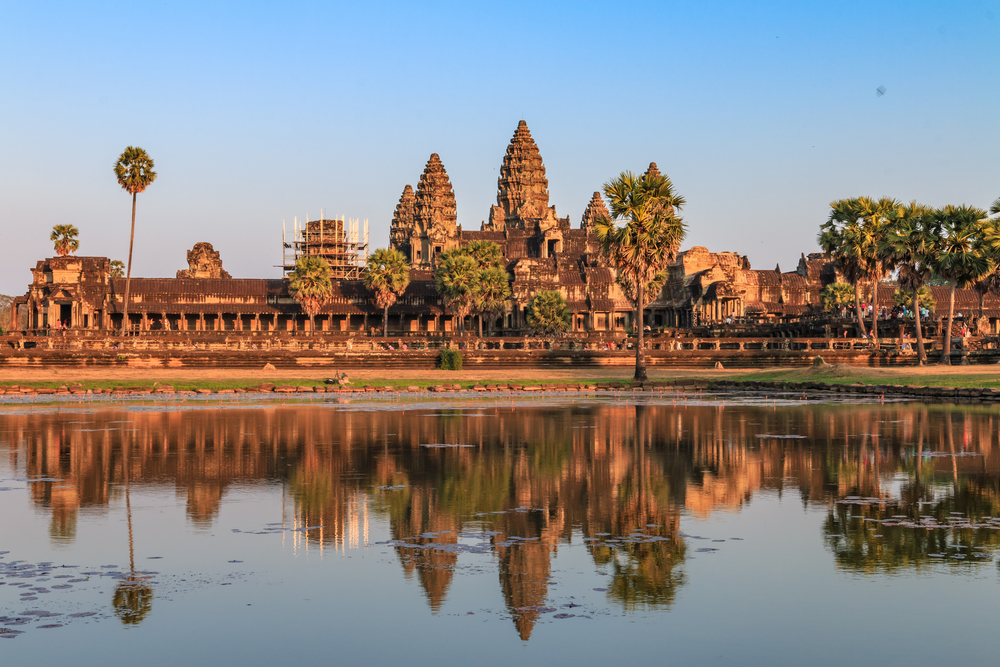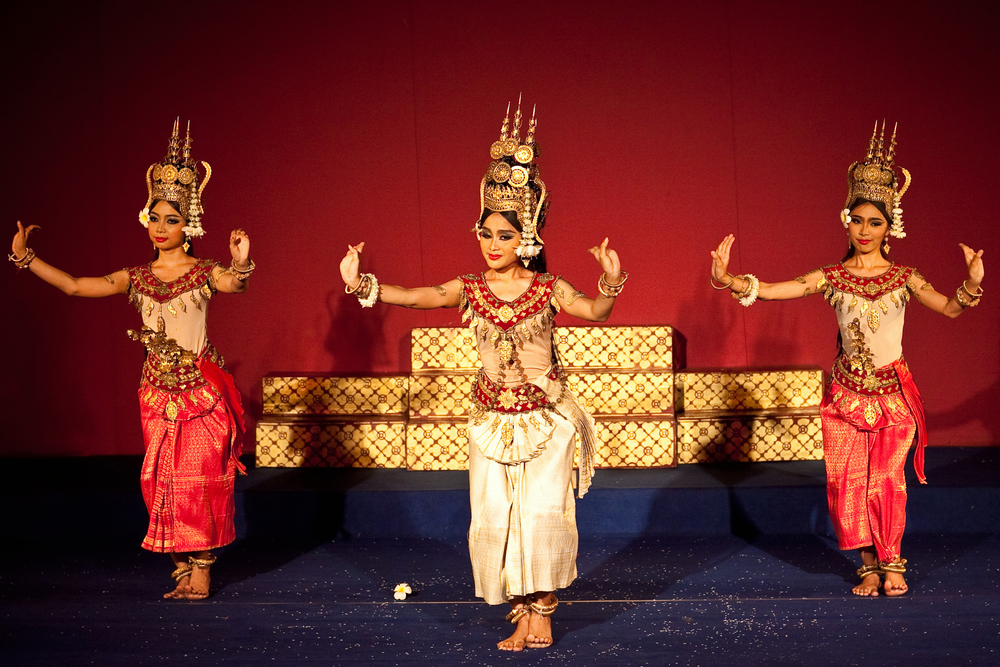Cambodia - history
Early History of Cambodia
The origin of the Cambodians is debatable among the scholars. Some say their original settlement was established in the south of Malaysia and Indonesia, while the others believe they migrated from the south of mainland China or India. However, the pottery found in Laang Spean Cave located in the Northeast of Cambodian confirmed the evidence that people had lived on this land since 4200 BC. It is believed the groups of people living nearby Mekong River plain and Bassac River are likely to be one of the Cambodian ancestors.
Historically, Cambodian society started developing when adopting Hindu culture being assimilated into the native culture. It led to the establishment of the ancient kingdom of “Funan” (1st -6th century C.E.). A process of adopting the Hindu culture was considerably slow and unclear. According to the Cambodian folklore of Phra Thong and Nang Nak, the Brahmin, Kaundinya, who possessed a magical arrow, had appeared on the land and later married the daughter of Naka, Soma.
He founded a state of Kamboza as it emerged in a documented evidence of China stating that Funan’s tributes had been regularly paid. Nonetheless, it is difficult to confirm whether Kingdom of Funan was a small state, a city-state or a pre-city state. It is also believed Funan had its own irrigation system supplies agricultural activities, especially the rice farming on lower land, while other areas allowed the rice farming on higher land, taro and sweet potato farming, hunter and gatherer.
After the 500 A.D., Funan started declining when the center of power was moving deeper to a land called Chenla located on the North of Funan. Its territories included the middle and lower parts of Mekong River. It is presumably possible that Chenla, once a colony of Funan, had conquered the kingdom. There was no tributes paid to China after that, so the younger generation lacks Chinese records to study what was happening at that period of time.
However, the Tang Dynasty chronicles during 706 A.D. mentions about Land Chenla and Water Chenla. The land had undergone a secession dividing the old kingdom into the northern part and the southern part. After the course of time, Land Chenla extended its influences. It wasn’t until 8th century when it developed to be one glorious and sturdy kingdom. The turning point of Chenla refers to one of the Java’s stone inscriptions that includes the oral records of Arabian traders. It inscribes how the Khmer king was defeated by forces of Java’s Maharaj of Sailen Dynasty.
Angkor Empire
The Sdok Kok Thom Inscription explains a further development of Chenla that King Jayavarman II had perform a sacred ritual enthroning and recognizing himself as “Universal Monarch” in 802 A.D.. Despite the fact that the evidence identifying a relation between Jayavarman II’s succession and the previous dysnasty of Chenla, it is believed he came from Java. The idea offers a possibility his family might have resettled in Java when the turmoil in Chenla broke down. The king himself may have been a captive of the Sailen court.
What is crucially important when he rose to throne is a critical transition from fragmented regions to Devaraja or God King of Angkor Empire. Any rituals conducted implies the king is no commoner but rather the one sharing a special relation to Shiva.
With that being said, he successfully changed the people’s belief. The following kings and the people had believed in Animism, and later revered him Jayavarman II as their Genesis.
The next prominent king after Jayavarman II is Indravoram, who succeeded the throne by seizing power from Jayavarman III, the son of the first king of Angkor Empire. He formed a tri-obligation model passing on the following kings. The tri-obligation includes irrigation supports, building a hug Baray and praising parents and ancestors. The praises could be seen in a form of the image of that person in the temple. The king also commissioned building a pyramid-like shrine on a mountain in hopes it would be his royal tomb.
Though the Khmer had a belief in Devaraja, not every king held absolute power. Many reigns saw a decline in power due to personalities and some other factors.
Jayavarman II is regarded as the most powerful king in Khmer history. The kingdom under his reign was even more unified when compared to the former reigns showing turbulent times. Some period even witnessed a few of self-entitled kings at the same time.
Jayavarman II’s strength saw the kingdom extending its boundaries further than ever. He conquered the Cham on the east or the now Vietnam and also marched his armies to Annam on the north of Vietnam. He defeated the Mon, whose settlement had been nearby Irrawaddy River, or West of Thailand now while even going further to northern parts Malay Peninsula.
Dedicating his strong faith in Shiva, Jayavarman II built the Great Angkor Wat in an arbitrary manner. The sacred place was meant to revere the gods and be a home to his majestic soul when he died.
Buddhism had started gaining influences on Khmer traditions and beliefs under Yasovarman’s rule (889-910). It was until the reign of Jayavarman V when Buddhism made its appearance in his court. In spite of his belief in Shiva, he embraced the religion’s developing influences. However, most of the Khmer kings were devout Brahman followers. Some had interests in Mahayana Buddhism.
Jayavaman VII was immensely interested in Buddhism, so the king, himself, introduced the concept of Bhudda Raja or the Bhudda King, and managed to rule with this administration. It is considered a revolutionary belief as opposed to the unshakable Devaraja. The kings once had had a close relation to gods making their subjects believe it commanded wind and rain. On the other hand, the amplitude was brought to the Buddhist kings who ruled with kindness. One of the inscriptions has it that Jayavarman VII commissioned building roads throughout the kingdom. His subjects viewed it as an act of kindness.
Post-Angkor Empire
The Khmer ancient temples built, a number of stone inscriptions, irrigation systems and the Brahman-Hindu dominant court determines the glorious days of Angkor Empire. However, from 1431-1863, the kingdom fell into a great decline. Not only did it lack factors determining progressive developments and monarch power, but it was wounded being a bumper state between Siam and Vietnam.
In 1353, Siam had marched its armies and conquered Angkor Empire foo the first time before Khmer was attacked again in 1431. It was a turbulent time that saw Angkor Empire moving its capital city from Lawag to U-dong before resettling in Phnom Penh in 1437. The new location provided water transportations allowing controlling trading routes. Products from China were transferred to Laos as it was a joining points between 3rivers: Mekong River, Sap River and Bassac River. In addition, Phnom Penh was far from Ayutthaya, so it could be safer. It is a dramatic change for the Khmer society at that time. The heart of the kingdom, the inner land, having been employed as rice farming was shifted to the waterfronts that allowed trading.
Nonetheless, for the next 200 years, Angkor Empire was warring with Siamese court from time to time trading off a few triumphs for a number of losses. Angkor Empire, finally, had fallen into the hands of Siam while the Vietnamese started migrating to Mekong Delta, where the Khmer had ear;ier occupied.
During the mid-18th century, Siam was defeated by Myanmar resulting in the second falling of Ayutthaya. It would not take long to recover when the new era of Rattanakosin began. King Rama I employed a strategy of divide and rule in which no lands having enough strength to challenge Siam.
Angkor Empire at that time was pressed by Siamese influences on the west while being pressured by Vietnam on the east. It was conquered by Siam and Vietnam from time to time making it difficult for the Khmer kings to rule under such inferior circumstances. The Khmer kings sometimes invested a close relation to Siamese court for that it would counterbalance the Vietnamese side. On the contrary, some kings preferred leaning heavily on Hue court, and unavoidably displeased the Siamese court. However, lacking absolute power that determines the future of the kingdom absolutely does no good to the enthroning kings. The scholars offer the analysis that the effects regarding Siam and Vietnam ever growing in power lessen respectability once the Khmer enjoyed.
Emperor Minh Mang of Vietnam proclaiming the authority over Khmer land caused pains and adversaries among the Khmer. He forcefully asserted a policy of turning Khmer into Vietnam sending his people to rule Angkor Empire in a colonial manner, forcing Khmer people to speak Vietnamese and drafted them into forces. It wasn’t until the late 19th century when riots broke out. Vietnam responded with the hired Cham armies.
Colonial Period of Cambodia
It was a short period of time when Cambodia did not fall under Siamese or Vietnamese influences enabling her to resume a short-lived independence. Unfortunately,during the mid-19th century, Cambodia was facing French colonialism occupying Vietnam, Laos and Cambodia and making them the French Indochinese colonial authorities. France had first started invading Vietnam while making its own business to penetrate into Cambodia with a promising gesture supporting Cambodia under King Ang Doung to achieve its independence from Siam. It wasn’t until the king passed in 1860 when, his successor, King Norodom Proborirak, signed treaty with France allowing Cambodia to become one of the French protectorates in 1863. The king later sent his royal letter to King Rama IV of Siam claiming France had forced him to sign such treaty. In response to that incident, King Rama IV managed to draw up another treaty reclaiming Cambodia was one of the Siamese protectorates. It upset France. Siam, therefore, was forced to cancel that treaty and it did in 1867. However, Siam insisted on its rights over the three provinces: Siem Reap, Battombong and Sri Sopon.
Since then, France had started extending the influences in Cambodia. It managed to install systems there while reforming the administration in ways that favored France. More taxes levied for the new state greatly affected those generating lower incomes, so the protests against Cambodia that had bowed down to France and also against the French. It spread like wildfire. However, France accused of King Norodom, whom it believed to be a wire-puller. The government was forced to put down the protests, so a great number of the protestors fled to Siamese administrative districts. King Norodam died in 1904. Prince Sisowath, the younger brother of the passed king, secured the succession with the French supports. In that same year, he signed a contract giving up his power and granting it to France, allowing the French government to hold power over Cambodia. France, later, declared Cambodia as one of French Indochina.
King Sisowath died in 1927. Prince Sisowath Monivong, his son, succeeded the throne. His reign was challenged by the communist influences extending from Vietnam to Cambodia. The communist movement in Cambodia joined the Communist Party of Indochina founded by Ho Chi Minh in liberating the Indochinese countries from French occupancy. Japan, later, played a vital in Indochina.
After France had lost Germany during the Second World War in 1940, Indochina was entirely occupied by Japan. Nonetheless, France was able to attain to holding its administrative authorities over those countries. It was still properly executing under Japanese eyes. In 1941, King Sisowath Monivong passed away, France decided to enthrone his nephew, Norodom Sihanouk.
Though allowing France to rule over Cambodia, Japan secretly communicated with the Cambodian patriots moving against France. It promised to liberate Cambodia from French authority, yet exploited this group to sabotage the French interests. In 1945, Japan declared the end of French rule over the entire Cambodia, and supported Cambodia to form its own government with King Noromdom Sihanouk on the throne. Son Ngoc Thanh, the leader of anti-Frrench movements, having saught asylum in Japan earlier, returned to his home country as the first prime minister of Cambodia. However, Germany and Japan lost the war in that year. France being able to resume its authority in Cambodia overthrew the government legitimized by Japan and arrested Son Ngoc Thanh. The anti-French movements fled into exile where most crossed the Thai border and formed United Issarak Front.
The group fighting wars against France received supports from Viet Minh. On the other hand, King Sihanouk took the French side while being legitimized by Japan’s authority. His relentless attempt in convincing and negotiating with the French government to grant sovereignty to Cambodia resulted in another political bloc. Khmer Serei was one of the politically active groups and received supports from the US that wanted to extend influences in this region. After the Second World War, Khmer Serei was fighting against the United Issarak Front and King Sihanouk’s bloc.
In 1946 Cambodia could set up political parties while France allowed the democratic administration there under French supervision. The first general election and the first constitution took place. Finally, France liberated Cambodia in late 1953.
Political unrest period of Cambodia
According to Geneva Conventions, Cambodia achieved independence from France in 1955 that saw King Sihanouk abdicate in favor of his father, Norodom Suramarit so that he could freely pursue politics. Sihanouk founded a political party, People's Socialist Community, or Sangkum Reastr Niyum, to compete in a general election. The party later won and he became the prime minister of Cambodia. His earlier gestures towards the US were attentive, however; his relationships with the communist nations like China and North Korea were to strike a counterbalance with the US.
When the Vietnam War broke out, the relationships between Cambodia and United States, whose actual opponents were China and North Vietnam, was deteriorating. Cambodia was unhappy the US was secretly exploiting it as war base fighting against Communism. It did affect Cambodian internal affairs. Therefore, developing a better relationship with China was inevitable. When United States and South Vietnam pushed Viet Cong or North Vietnam to the point of retreat, Sihanouk allowed the Viet Cong the entrance to the country. The group forged their war base with a route, transferring weapons from China permitted. It is obvious Sihanouk’s government was taking up a stance against United States causing a stir among its people because it brought the nation into conflict of others. General Lon Nol, the rightist member of the party, was the active leader. In 1966, Sihanouk started losing his momentum from the within while General Lon Nol was rising to power with supports to become prime minister instead of Sihanouk.
In 1970, Lon Nol gaining major favors from the United States decided to stage a coup introducing the country to a republic era. He became the first president of Khmer Republic.
The leftist groups including ones joining the former government was fleeing the rightist purge serving the US purpose after the coup had been staged. Cambodian Civil War broke out. Sihanouk declared the government in exile in Peking disapproving Lon Nol government’s legitimacy. This movement was backed by China making the organization even stronger and grow faster. A great number of members joining succeeded in penetrating into Cambodian rural areas where the small town strategy was expected to work as it had earlier in China. United States, the giant opponent of China, deliberately supplied Lon Nol’s government by bombing Khmer Rouge strongholds, providing finance and supplying weapons. However, in 1975, Khmer Rouge occupied Phnom Penh.
A policy Khmer Rouge led by Pol Pot wished to implement was to build up a new state and isolate the nation according to the Maoist concept. It went against the will of Sihanouk, thereby, he discontinued his Head of State. In 1976 Khmer Rouge appointed Khieu Samphan, Sihanouk’s former minister and one of Khmer Rouge leaders, as the Head of State in which Prime Minister Pol Pot took complete control of administrative power. They continued purging the opponents in ways in which Sihanouk was put under house arrest while Khmer Rouge’s political rivals were brutally wiped out of Cambodia. They paved ways to build a new society in favor of their ideology and proclaimed Democratic Kampuchea.
The Pol Pot-led government had enjoyed the power until 1979 when another Khmer communist organization, Heng Samrin being backed by Vietnam had enough. He seized power and declared People’s Republic of Kampuchea. Khmer Rouge could not surrender making an attempt in joining Sihanouk’s bloc that founded a pro-royalist political party, FUNCINPEC. Altogether with Khmer People’s National Liberation Front led by the rightist Son Sann, the three formed Coalition Government of Democratic Kampuchea in order to secure a seat in United Nation.Khmer Rouge dissolved Communist Party of Kampuchea for that the coalition would win legitimacy among other nations.
The coalition was successfully formed, meanwhile, the Civil War broke out. The coalition government was fighting against Heng Sumrin’s side in hopes to push Vietnamese forces out of Cambodian borders. With international pressure, Vietnam finally decided to retreat in 1989. Then, the negotiations started on the table not on the battle field, and that earned a peace agreement in 1991. The monarch was restored and the nation’s official name pronounced Kingdom of Cambodia. Sihanouk ascended to the throne again.
Bibliography
เขียน ธีระวิทย์ และสุนัย ผาสุก. (2543). กัมพูชา ประวัติศาสตร์ สังคม เศรษฐกิจ ความมั่นคง การเมือง และการต่างประเทศ. กรุงเทพฯ: สำนักงานกองทุนสนับสนุนการวิจัย และ สถาบันเอเชียศึกษา จุฬาลงกรณ์มหาวิทยาลัย.
เดวิด พี แชนด์เลอร์. (2543). ประวัติศาสตร์กัมพูชา. (พรรณงาม เง่าธรรมสาร และคนอื่นๆ, ผู้แปล) กรุงเทพฯ: มูลนิธิโครงการตำราสังคมศาสตร์และมนุษย์ศาสตร์.
ดวงธิดา ราเมศวร์. (2555). ประวัติศาสตร์ประเทศในกลุ่มอาเซียน: ไทย ลาว พม่า กัมพูชา. กรุงเทพฯ: แพร-ธรรม.
ธีระ นุชเปี่ยม. (2542). การพัฒนาเศรษฐกิจและการเมืองกัมพูชา. กรุงเทพฯ: คบไฟ.
มัลลิกา พงศ์ปริตร บรรณาธิการ. (2544). ลาวและกัมพูชา. (พวงนิล คำปังสุ์, ผู้แปล) กรุงเทพมหานคร: สำนักพิมพ์หน้าต่างสู่โลกกว้าง.
รัชดา ธราภาค. (2555). ราชอาณาจักรกัมพูชา. กรุงเทพมหานคร: สำนักพิมพ์สถาพรบุ๊คส์.
สุธาชัย ยิ้มประเสริฐ. (2556). กัมพูชา. กรุงเทพมหานคร: ชมรมโดมรวมใจ.





